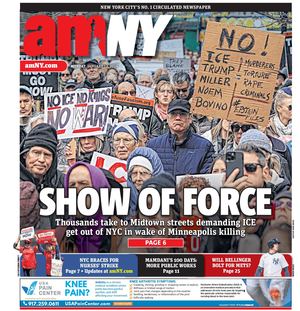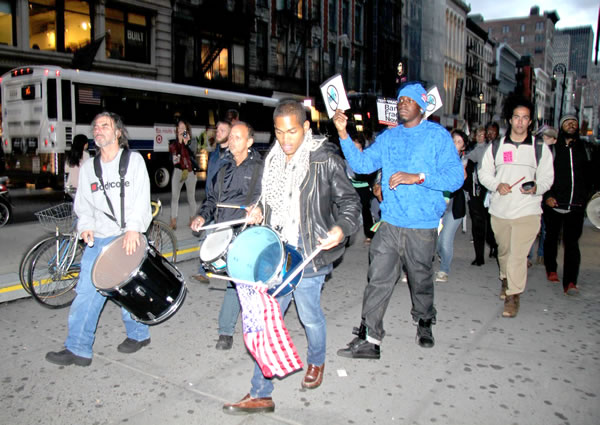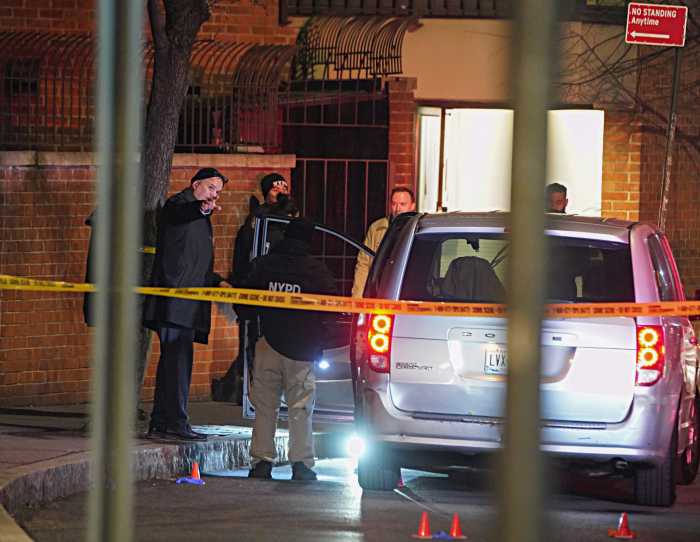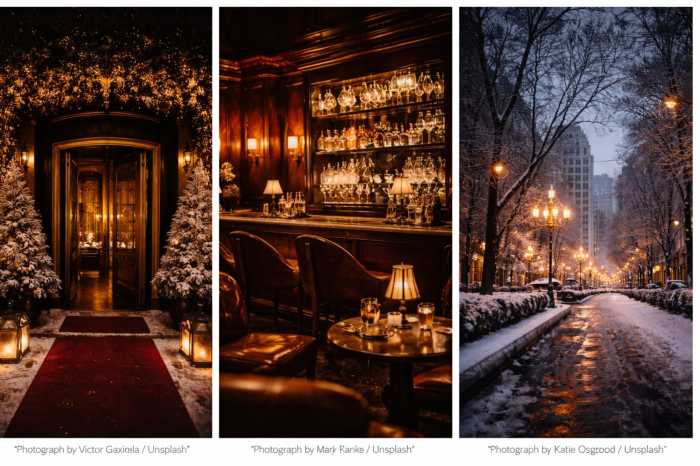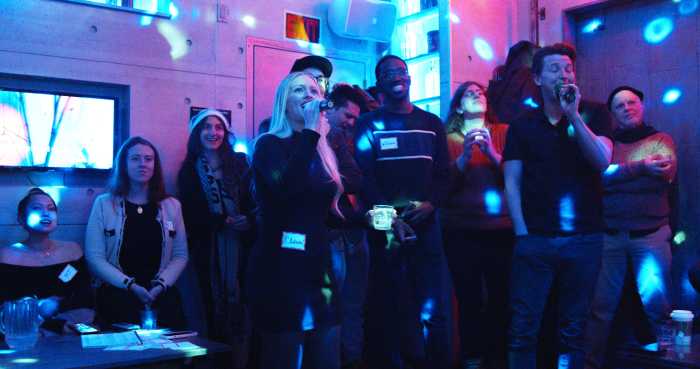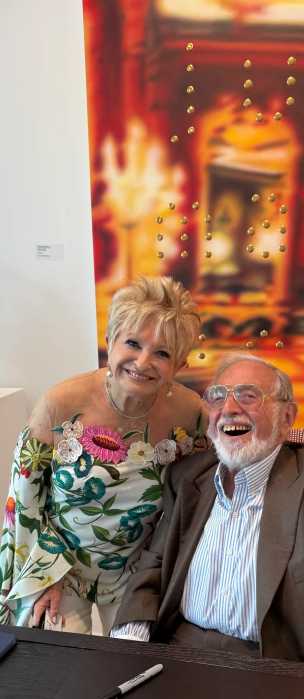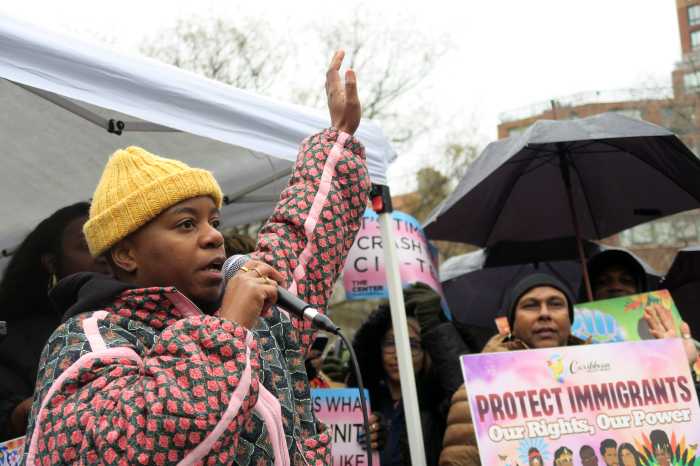By Albert Amateau
Environmental activists, one of them dressed in a hazmat suit and another as the Grim Reaper, filled the auditorium at P.S. 41, the Greenwich Village School, last week for a federal hearing on Spectra Energy’s proposed 30-inch natural gas pipeline.
The crowd, many of whom had marched up to the Village from the Occupy Wall Street demonstration, waved “No Pipeline” signs and at one point shouted down a Federal Energy Regulatory Commission staff member.
The three-hour Oct. 20 public comment session was not all guerilla theater.
Despite Spectra’s assurance that the pipeline would meet or exceed federal safety measures, representatives of the Sierra Club, the Sane Energy Project, NYH2O and other environmental groups cited a series of devastating gas pipeline accidents. Critics voiced fears about potential terrorism and doubts about whether the city would really need the large amounts of natural gas that the pipeline would bring to Manhattan.
Borough President Scott Stringer, Community Board 2 and other pipeline critics said the proposed pipeline would promote the delivery of natural gas from high-volume horizontal hydraulic fracturing in the Marcellus Shale formation in New York State’s southern counties along the Pennsylvania border.
The controversial process, known as fracking, has been cited as a threat to water resources. Critics also fear that natural gas from fracked wells could bring radon — radioactive material from deep in the earth — to the kitchens of New York City homes.
Mark Ruffalo, the actor and director who lives Upstate in the Marcellus Shale region, said he has been fighting the threat of fracking for the past three years.
“Isn’t there a point where we say, ‘Enough is enough?’” he said. “We will pay an enormous cost for relying on carbon-based fuels for another 30 years and make it less and less possible to change a disastrous course.”
In a prepared statement, Stringer cited a blowout in Pennsylvania earlier this year that caused toxic fracking fluids to pour into a local river for 13 hours. Stringer, however, agreed with the city’s assessment that cleaner-burning natural gas is needed to replace the high-polluting No. 4 and No. 6 heating oil used in the city’s older housing stock.
But other critics, including the Sane Energy Project, insisted that the estimated need for natural gas was inflated.
Moreover, Clare Donohue, a founder of Sane Energy Project, doubted that the Federal Energy Regulatory Commission was really conducting a review of the pipeline.
“Many of us feel FERC is just using this process as the due diligence that it needs to approve the project,” Donohue said, charging that the agency considers Spectra’s convenience above all other issues.
Mav Moorhead, a member of NYH20, declared, “FERC has never stopped a pipeline from approval. After a final ruling the only recourse is to sue in federal court. Historically, that is the only way to stop the pipeline at this time.”
Moorhead said that Spectra’s ultimate goal was to create a worldwide market for natural gas from Marcellus Shale fracking.
Stephanie Low, a member of the Atlantic chapter of the Sierra Club, questioned Spectra Energy’s safety record. Company affiliates were cited 17 times in June for inadequate safety procedures, Low said. In British Columbia, two of Spectra’s gas processing plants were named the highest and third highest polluters in the province. Low cited two explosions of a Spectra underground storage reservoir in Texas and a 1994 pipeline explosion in Edison, N.J.
“What will Spectra or the Federal Energy Regulatory Commission say to us when this project blows up in our faces?” Low asked. “Who will put up the money to rebuild a neighborhood? How will you bring back our dead? Why are you seriously considering this project?” she asked.
Cost of the 30-inch line, officially known as The New Jersey-New York Expansion Project of the Texas Eastern / Algonquin Gas Transmission Pipeline, is estimated at $860 million. Texas Eastern and Algonquin are Spectra Energy affiliates.
The pipeline would transmit natural gas from an existing line in Linden, N.J., to Staten Island, then to Bayonne and Jersey City, N.J., and then across the river to the southwest corner of Gansevoort Peninsula — which is slated for development into an 8-acre park as part of Hudson River Park.
The line would cross the peninsula, park, bikeway and West Side Highway, cross to the east side of the highway and end at a converter valve just north of the new Whitney Museum, which is now under construction. From there, Con Edison plans to build a pipeline along 10th Ave. 1,500 feet north to 15th St. to connect with an existing Con Edison feeder line.
The entire line, including the Con Edison section, would be buried at a depth of 4 feet, or 12 inches below any other utility line, whichever is deeper. However, the Con Edison section is not part of the FERC review.
The Community Board 2 resolution submitted to FERC notes that Con Edison must still present plans for its section of the pipeline to the board. C.B. 2 also notes that an entirely separate project for a 26-inch pipeline to bring natural gas to Brooklyn is also under review.
“It is not clear that such a vast increase in the supply [of natural gas] is warranted without current detailed statistical data to back it up,” the board resolution says.
C.B. 2 also wants the pipeline to be smaller than the proposed 30 inches to minimize potential damage within a crowded urban environment. The board also wants the line to be buried deeper than currently planned.
The board resolution demands that Spectra install automatic emergency shutoff valves instead of the planned remote-controlled shutoffs.
“It is vital that Spectra install an automatic shutoff valve where the pipeline emerges from the riverbed on the Gansevoort Peninsula and that Con Edison install an automatic shutoff at the converter valve on 10th Ave. and Gansevoort St.,” the board resolution said.
The board also notes that the draft environmental impact statement under review must specify any measures needed to minimize the pipeline’s impact on the Hudson River Park bikeway.
